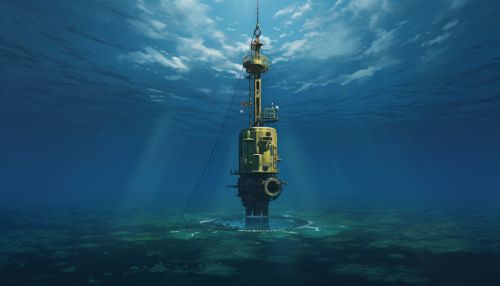Piston corer
Introduction
A piston corer is a type of oceanographic sampling equipment used to collect sediment samples from the ocean floor. It is a long, hollow tube that is driven into the seabed to collect a sample of the sediment layers. The piston corer is a critical tool in the field of marine geology, enabling scientists to study the composition and history of the ocean floor.


Design and Operation
The piston corer consists of a long, hollow tube known as the coring barrel. The coring barrel is typically made of steel and can range in length from a few meters to over 30 meters, depending on the depth of the sediment to be sampled. At the bottom of the coring barrel is a cutting shoe, a sharp-edged device that cuts into the sediment as the corer is driven into the seabed.
Inside the coring barrel is a piston, which moves up and down within the barrel. As the corer is driven into the seabed, the piston moves up, creating a vacuum that helps to pull the sediment sample into the coring barrel. Once the corer is retrieved, the piston is pushed down to expel the sediment sample.
The piston corer is typically deployed from a research vessel using a winch and a steel cable. The corer is lowered to the seabed, and then a weight is dropped down the cable to drive the corer into the sediment. The corer is then retrieved, bringing with it a sample of the sediment layers.
Applications
Piston corers are used in a variety of oceanographic research applications. They are particularly useful for collecting sediment samples from deep-sea environments, where the sediment layers can provide a record of past ocean conditions and climate change.
In paleoceanography, piston corers are used to collect sediment cores that can provide a record of past ocean conditions. These cores can be analyzed to determine changes in temperature, salinity, and other ocean conditions over time.
In marine geology, piston corers are used to study the composition and structure of the ocean floor. The sediment samples collected can provide information on the types of rocks and minerals present, as well as the processes that have shaped the ocean floor.
In environmental science, piston corers are used to study the impact of human activities on the ocean floor. For example, they can be used to collect samples of sediment contaminated by pollutants, or to study the effects of deep-sea mining.
Advantages and Limitations
Piston corers offer several advantages over other types of oceanographic sampling equipment. They are capable of collecting long, undisturbed samples of sediment, which can provide a detailed record of past ocean conditions. They are also capable of sampling deep-sea environments, which can be difficult to access with other types of equipment.
However, piston corers also have some limitations. They can be difficult to use in environments with hard or rocky sediments, as the coring barrel may not be able to penetrate the seabed. They also require a research vessel and a winch for deployment, which can be expensive.
